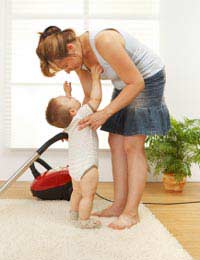Coping With Dust Allergy

House dust is a mixture of things – human and animal skin and hair, fine grit from the soil, pollen and house dust mites. All houses have dust, but some people develop an allergy to certain parts of it.
What Is Dust Mite Allergy?
The most common cause of house dust allergy is an allergy to a protein in the dust mites and especially their faeces (droppings). Dust mites are bugs that are around 0.4 mm long and blue, and are related to spiders. Mites live in carpets, mattresses and pillows, blankets and other bedding, curtains and soft furnishings, and eat shed skin cells from humans and animals.Symptoms of Dust Allergy
Symptoms of dust mite allergies include runny nose, coughing, and itchy or teary eyes. Dust mite allergy in children can lead to asthma, and can make existing asthma and eczema worse (see also ‘Coping with Asthma’ and ‘Coping with Eczema’).Keeping the Dust Down
Keeping the dust down is a huge part of managing dust allergies. Vacuum regularly (including the mattress and soft furnishings) using a vacuum cleaner with a HEPA filter, and dust with a damp cloth (or a cloth designed to trap dust) to keep dust mite levels down. Steam cleaning will kill dust mites in soft furnishings, but try a spot clean in a small area first to make sure that it won’t damage the fabric, and dry it out thoroughly afterwards and air the room to get rid of the steam. Changing from carpets to laminate or wood floors can help – washable rugs will make the room feel warmer, and can be put in the washing machine regularly.Wrap mattresses and pillows in dust-proof covers. Washing bedding will get rid of dust mite waste, and high and low temperatures (e.g. wash at 60ºC or freezing) will kill the mites. Try adding borax to the wash cycle for fabrics that can’t be washed at high temperatures.
Children’s soft toys are a common refuge for dust mites, so it’s a good idea to freeze the toys every now and then to kill the mites (though some children might get upset seeing Teddy going into the freezer in a plastic bag…) People are often recommended to avoid feather pillows – however, a study in the British Medical Journal showed that polyester pillows can hold more dust mite particles than feather pillows.
Dust mites like humidity, so keeping the covers pulled back on the beds and airing the mattress, duvets and pillows regularly should help, especially on hot, sunny days. Using a dehumidifier will reduce the overall humidity in the house.
Curtains can collect dust, as can Venetian blinds – wash or steam curtains and damp dust blinds regularly, or think about swapping to roller blinds. Keep ‘stuff’ around the house to a minimum – it can all trap dust.
Although it’s important to get children involved in jobs around the house, children with dust allergies should avoid doing dusty jobs if possible, or wear a dust mark.

Re: What You Should Know About Poisonous Plant Allergies
Just to help others ,my partner had occasional breathing problems and swollen glands in her neck…
Re: Coping With Eczema
@Char. There's lots of help and medications for eczema nowadays, you need to go and see your doctor to establish which treatment would work…
Re: Coping With Eczema
I'm 14 years old and I have a condition called eczema it's itchy dry and Uncomftable too cope with please could you give me advice thanks.
Re: Allergic Conjunctivitis
@mans. This is not unheard of and there are lots of possibilities including an allergy to something that you/the medical staff have not…
Re: Allergic Conjunctivitis
My grandson is 13yrs old and has in the last three months had a couple of anaphylactic episodes that required us to take him to the er to…
Re: Allergic Reactions in Babies
My son had a allergic reaction to Nurofen Ibruperfen, he is severely ill almost fatal. I would like other people to be aware of…
Re: Allergies to Dogs and How to Prevent Them
Is a tekel miniature a dog that people are frequently allergic to
Re: Allergic Reactions in Babies
Just started weaning my 6 month old and she is reacting to a number of foods. Reactions are usually red blotches around her mouth…
Re: Pets for Allergic Children
My daughter has been positively tested for allergies to both cats and dogs. She had 2 severe asthma attacks after we bought a kitten.…
Re: Hayfever in Children
Don't know whether it's climate change but I keep hearing about more and more plants that affect hayfever - making the sneezy season longer…